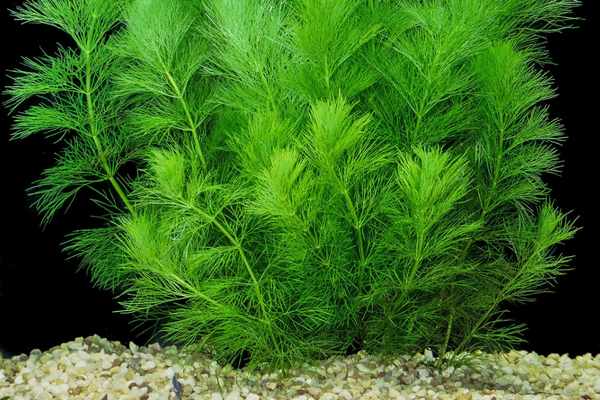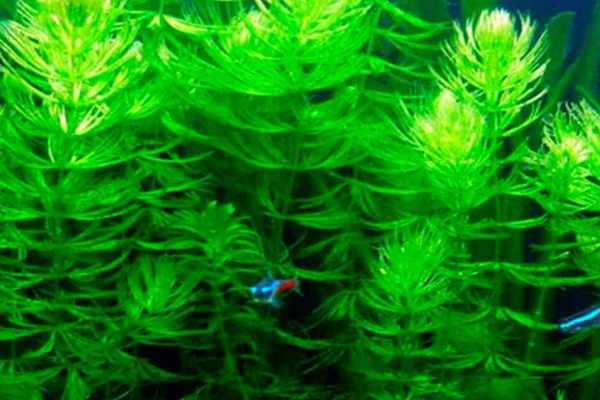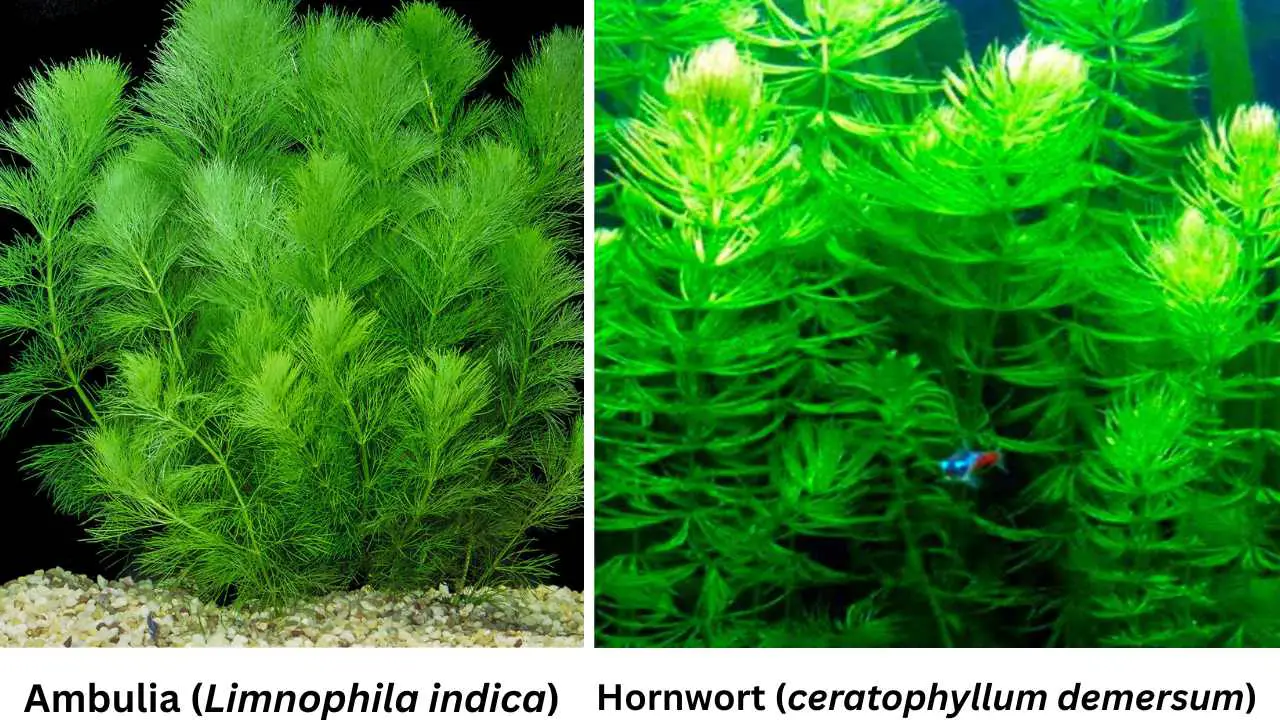Ambulia (Limnophila indica) and hornwort (Ceratophyllum demersum) are two types of aquatic plants that are commonly used in aquariums and ponds. Both plants play an important role in maintaining a healthy aquatic ecosystem by providing oxygen and serving as a food source for fish and other aquatic life. However, despite their similarities, ambulia and hornwort have distinct physical characteristics and growing habits. In this article, we will take a closer look at these two plants and compare their similarities and differences.
Overview of Ambulia and Hornwort
Ambulia (Limnophila indica), also known as water hedge, is a type of floating plant that is native to Asia. It has small, delicate leaves and a creeping habit, which makes it a popular plant for freshwater aquariums. Ambulia can be used to cover the surface of the water and reduce evaporation, as well as to control algae growth.
Systematic Position of Ambulia
Kingdom: Plantae
Clade: Angiosperms
Order: Lamiales
Family: Plantaginaceae
Genus: Limnophila
Species: Limnophila indica
Hornwort (Ceratophyllum demersum), on the other hand, is also known as rigid hornwort, coontail, or coon’s tail, is a hardy, submerged plant that is native to North America, Europe and Asia. It has long, thin leaves that can reach up to 12 inches in length. Hornwort is commonly used as a spawning medium for fish, as well as a food source for aquatic animals. It is found in both freshwater and saltwater environments.
Systematic Position of Hornwort
Kingdom: Plantae
Clade: Angiosperms
Class: Anthocerotopsida
Order: Ceratophyllales
Family: Ceratophyllaceae
Genus: Ceratophyllum
Species: Ceratophyllum demersum
Both Ambulia and Hornwort are easy to care for and require minimal maintenance. They can be propagated by cutting and planting the cuttings.
Habitat and Distribution
Ambulia (Limnophila indica) is native to Asia and is typically found in shallow, freshwater environments such as ponds, lakes, and slow-moving streams. It prefers warm temperatures and can be found in both natural and man-made aquatic environments.
Hornwort ((Ceratophyllum demersum), on the other hand, is native to North America, Europe, and Asia and can be found in a wide range of aquatic environments, including freshwater and saltwater. It can grow in a variety of water conditions, from fast-moving streams to stagnant ponds, and can tolerate a wide range of temperatures.
Physical Characteristics
Ambulia (Limnophila indica) has small, delicate leaves that are typically green in color. The leaves are arranged in a spiral pattern around the stem and can reach a length of about 1 inch. The stems of the plant are thin and can reach a length of about 6 inches. The plant has a creeping habit, which means that it will spread out and cover the surface of the water.

Hornwort (Ceratophyllum demersum), on the other hand, has long, thin leaves that can reach up to 12 inches in length. The leaves are typically green in color, but can also have a brown or reddish tint. The leaves are arranged in a spiral pattern around the stem and are feathery in appearance. The stems of the plant can reach a length of several feet and are typically thin and brittle.

Aquarium and Pond Use
Ambulia is a popular plant for freshwater aquariums and is often used to cover the surface of the water. The plant’s floating habit helps to reduce evaporation and control algae growth. It also provides shade and hiding spots for fish and other aquatic life. Ambulia can be grown floating on the surface or with its roots submerged. When grown submerged, it tends to grow taller and bushier than when grown floating.
Hornwort (Ceratophyllum demersum), on the other hand, is commonly used as a spawning medium for fish and as a food source for aquatic animals. It can be used in both freshwater and saltwater aquariums and can provide shelter and hiding spots for fish. It is also used in outdoor ponds and water gardens, where it can help to oxygenate the water and provide food for fish and other aquatic life. Hornwort can be grown completely submerged or with its leaves floating on the surface of the water.
Maintenance and Propagation
Both Ambulia and Hornwort are easy to care for and require minimal maintenance. They can be propagated by cutting and planting the cuttings
Ambulia can be propagated by taking cuttings of the plant and planting them in the substrate or allowing them to float on the water’s surface. It prefers moderate to high light and can tolerate a wide range of water temperatures and pH levels. It can be fertilized with a liquid fertilizer to promote growth.
Hornwort (Ceratophyllum demersum) can be propagated by taking cuttings of the plant and planting them in the substrate. It prefers moderate to high light and can tolerate a wide range of water temperatures and pH levels. It can be fertilized with a liquid fertilizer to promote growth. It can also be planted in a mesh bag to prevent it from floating and spreading around the aquarium.
In terms of maintenance, both plants should be regularly trimmed to control their growth and prevent them from taking over the aquarium. It’s also important to check for and remove any dead or rotting leaves to prevent them from affecting the water quality.
Water Parameter Requirement
Both Ambulia and Hornwort are relatively tolerant of a wide range of water conditions, but they do have some specific water parameter requirements.
Ambulia prefers a pH range of 6.0 to 7.5 and a water temperature range of 60 to 86 degrees Fahrenheit (15 to 30 degrees Celsius). It can tolerate a wide range of water hardness levels, but prefers a moderate level of hardness.
Hornwort is also tolerant of a wide range of water conditions, but it prefers a pH range of 6.0 to 7.5 and a water temperature range of 60 to 86 degrees Fahrenheit (15 to 30 degrees Celsius). It can also tolerate a wide range of water hardness levels but also prefers a moderate level of hardness.
It’s important to note that maintaining stable water parameters is important for the health of the plants and the overall aquarium ecosystem. If the water parameters are not within the preferred range, it can cause stress to the plants, which can lead to decreased growth and increased susceptibility to disease.
Disease and Treatment
Both Ambulia and Hornwort are generally hardy plants, but they can be susceptible to a few common diseases, such as bacterial and fungal infections.
Bacterial infections can cause the leaves of the plants to turn yellow and rot. Treatment for bacterial infections includes removing infected leaves, increasing water flow to improve oxygenation, and using antibiotics specifically formulated for use in aquariums.
Fungal infections can cause the leaves of the plants to turn brown or black and rot. Treatment for fungal infections includes removing infected leaves, increasing water flow to improve oxygenation, and using antifungal medications specifically formulated for use in aquariums.
Another common problem with these plants is infestation of pests, such as snails, planaria and algae. To treat pests infestations is to physically remove them, use chemical treatment or introducing predators to the tank.
It’s important to note that preventing diseases is always better than treating them. To prevent disease from occurring, it’s important to maintain stable water parameters, provide adequate lighting and nutrition, and regularly check the plants for any signs of infection or infestation.
Comparison of Ambulia and Hornwort
Ambulia and Hornwort are both popular aquatic plants, but they have some distinct differences in terms of their physical characteristics, habitat and distribution, and uses in aquariums and ponds.
Physical Characteristics: Ambulia is a small, delicate, and fine-leaved aquatic plant that forms a dense, bushy growth. It has small, star-shaped flowers that can be pink, white, or purple in color. Hornwort, on the other hand, is a larger, coarser, and more robust plant that forms a long, feathery growth. It does not produce flowers, but it has small, inconspicuous, greenish-brown reproductive structures.
Habitat and Distribution: Ambulia is native to Southeast Asia and is found in freshwater habitats such as ponds, swamps, and marshes. Hornwort, on the other hand, is native to many parts of the world and is found in a wide variety of freshwater habitats, including rivers, lakes, and ponds.
Aquarium and Pond Use: Ambulia is often used as a background or midground plant in aquariums and can also be used as a floating plant. Its delicate, fine-leaved foliage provides a nice contrast to the larger, coarser-leaved plants. Hornwort, on the other hand, is often used as a background or midground plant in aquariums, and it can also be used as a floating plant. Its long, feathery foliage provides a nice contrast to the smaller, more delicate-leaved plants.
Frequently Asked Questions
Q-1: Can Ambulia and Hornwort be planted together in an aquarium?
A: Yes, Ambulia and Hornwort can be planted together in an aquarium. Both plants are relatively hardy and can tolerate a wide range of water conditions. They can be planted in different parts of the aquarium or in the same area, depending on the desired look of the aquarium.
Q-2: Do Ambulia and Hornwort need a lot of light?
A: Both Ambulia and Hornwort require moderate to high lighting to thrive. They can tolerate a range of lighting levels, but they will grow best in aquariums with high lighting levels.
Q-3: Can Ambulia and Hornwort be grown in a pond?
A: Yes, Ambulia and Hornwort can both be grown in a pond. They are hardy plants that can tolerate a wide range of water conditions and can be used to create natural-looking water gardens.
Q-4: Do Ambulia and Hornwort need fertilization?
A: Both Ambulia and Hornwort benefit from regular fertilization. They require a balance of macronutrients (such as nitrogen, phosphorus, and potassium) and micronutrients (such as iron and trace elements) to grow well. These can be provided by using liquid or tablet fertilizers specifically formulated for aquatic plants.
Q-5: Can Ambulia and Hornwort be propagated?
A: Yes, Ambulia and Hornwort can be propagated through a variety of methods, including by dividing the plants, taking stem or root cuttings, or by using specialized propagation tools like a propagating mat or a hornwort ball.
Q-6: Are Ambulia and Hornwort toxic to fish?
A: Both Ambulia and Hornwort are generally considered to be non-toxic to fish, and they are often used in aquariums with fish and other aquatic animals. However, it’s always good to research the specific species of fish you have in your tank to make sure they are compatible with these plants.
Conclusion
In conclusion, Ambulia and Hornwort are both popular aquatic plants that are often used in aquariums and ponds. Both plants require moderate to high lighting and regular fertilization to thrive and can be propagated through a variety of methods. Both are generally considered to be non-toxic to fish, but it’s always good to research the specific species of fish you have in your tank to make sure they are compatible with these plants.

